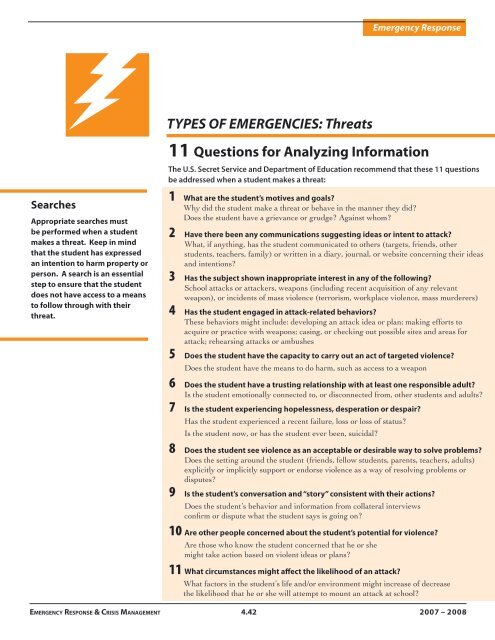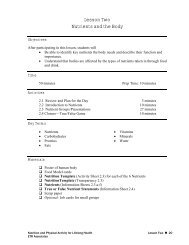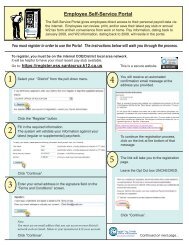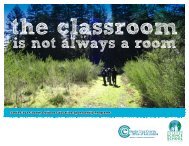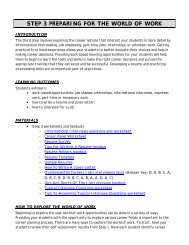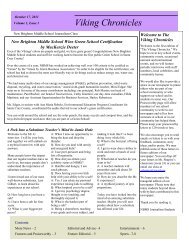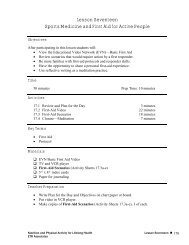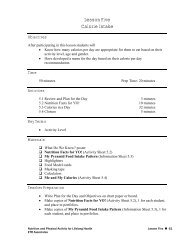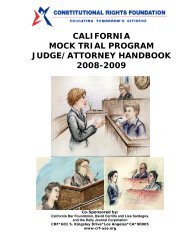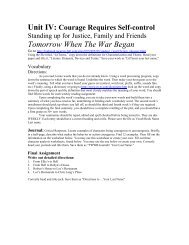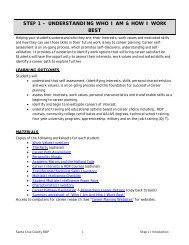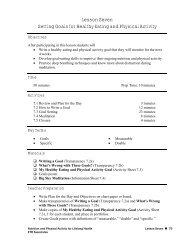4 Emergency Response - Santa Cruz County Office of Education
4 Emergency Response - Santa Cruz County Office of Education
4 Emergency Response - Santa Cruz County Office of Education
Create successful ePaper yourself
Turn your PDF publications into a flip-book with our unique Google optimized e-Paper software.
<strong>Emergency</strong> <strong>Response</strong><br />
Types <strong>of</strong> Emergencies: Threats<br />
11 Questions for Analyzing Information<br />
The U.S. Secret Service and Department <strong>of</strong> <strong>Education</strong> recommend that these 11 questions<br />
be addressed when a student makes a threat:<br />
Searches<br />
Appropriate searches must<br />
be performed when a student<br />
makes a threat. Keep in mind<br />
that the student has expressed<br />
an intention to harm property or<br />
person. A search is an essential<br />
step to ensure that the student<br />
does not have access to a means<br />
to follow through with their<br />
threat.<br />
1 What are the student’s motives and goals?<br />
Why did the student make a threat or behave in the manner they did?<br />
Does the student have a grievance or grudge? Against whom?<br />
2 Have there been any communications suggesting ideas or intent to attack?<br />
What, if anything, has the student communicated to others (targets, friends, other<br />
students, teachers, family) or written in a diary, journal, or website concerning their ideas<br />
and intentions?<br />
3 Has the subject shown inappropriate interest in any <strong>of</strong> the following?<br />
School attacks or attackers, weapons (including recent acquisition <strong>of</strong> any relevant<br />
weapon), or incidents <strong>of</strong> mass violence (terrorism, workplace violence, mass murderers)<br />
4 Has the student engaged in attack-related behaviors?<br />
These behaviors might include: developing an attack idea or plan; making efforts to<br />
acquire or practice with weapons; casing, or checking out possible sites and areas for<br />
attack; rehearsing attacks or ambushes<br />
5 Does the student have the capacity to carry out an act <strong>of</strong> targeted violence?<br />
Does the student have the means to do harm, such as access to a weapon<br />
6 Does the student have a trusting relationship with at least one responsible adult?<br />
Is the student emotionally connected to, or disconnected from, other students and adults?<br />
7 Is the student experiencing hopelessness, desperation or despair?<br />
Has the student experienced a recent failure, loss or loss <strong>of</strong> status?<br />
Is the student now, or has the student ever been, suicidal?<br />
8 Does the student see violence as an acceptable or desirable way to solve problems?<br />
Does the setting around the student (friends, fellow students, parents, teachers, adults)<br />
explicitly or implicitly support or endorse violence as a way <strong>of</strong> resolving problems or<br />
disputes?<br />
9 Is the student’s conversation and “story” consistent with their actions?<br />
Does the student’s behavior and information from collateral interviews<br />
confirm or dispute what the student says is going on?<br />
10 Are other people concerned about the student’s potential for violence?<br />
Are those who know the student concerned that he or she<br />
might take action based on violent ideas or plans?<br />
11 What circumstances might affect the likelihood <strong>of</strong> an attack?<br />
What factors in the student’s life and/or environment might increase <strong>of</strong> decrease<br />
the likelihood that he or she will attempt to mount an attack at school?<br />
Em e r g e n c y Re s p o n s e & Crisis Ma n a g e m e n t 4.42 2007 – 2008


